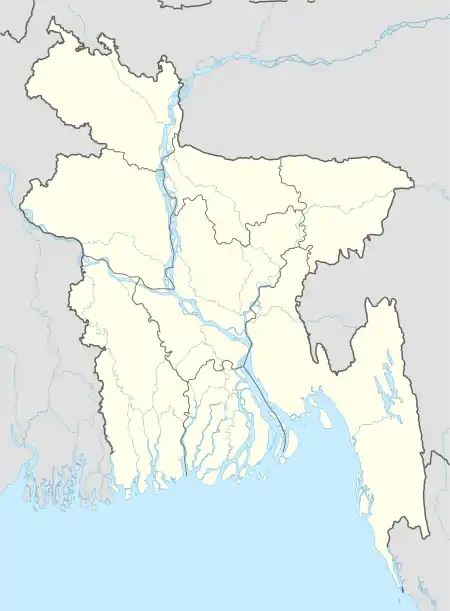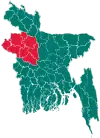Dhamoirhat Upazila
Dhamoirhat (Bengali: ধামইরহাট) is an upazila of Naogaon District in the Division of Rajshahi, Bangladesh. The main river of the Dhamoirhat Upazila is the Atrai.[1]
Dhamoirhat
ধামইরহাট | |
|---|---|
 Dhamoirhat Location in Bangladesh | |
| Coordinates: 25°8.7′N 88°51.7′E | |
| Country | |
| Division | Rajshahi Division |
| District | Naogaon District |
| Area | |
| • Total | 300.8 km2 (116.1 sq mi) |
| Population (2011) | |
| • Total | 184,778 |
| • Density | 610/km2 (1,600/sq mi) |
| Time zone | UTC+6 (BST) |
| Website | dhamoirhat |
History
During the War of Liberation, the Pak army had camped at places like Farsipara, Pagla Dewan, Rangamati, etc. A direct encounter between the Pak army and the freedom fighters were held at Piral Danga, Gangra, Kulfatpur and Rangamati with the heavy casualty on both sides. The Pak army burnt and sacked the village Kulfatpur and killed 14 innocent villagers. Marks of War of Liberation Mass grave: 2 (Farsipara, Pagla Dewan).
Geography
_Bangladesh.svg.png.webp)
Dhamoirhat is located at 25.1444°N 88.8611°E. It has 29661 households and total area 300.8 km2.
Dhamoirhat Upazila is bounded by Balurghat and Tapan CD Blocks in Dakshin Dinajpur district, West Bengal, India, on the north, Joypurhat Sadar Upazila on the east, Badalgachhi and Patnitala Upazilas on the south and Patnitala Upazila on the west.[2][3][4]
Climate
Dhamoirhat is placed in a monsoon area. In the summer, temp. is about 40 degree & in the rainy season(June–July) raindrops as well.
Demographics
At the 2011 Bangladesh census, Dhamoirhat had a population of 184778. Males constituted 51.73% of the population, and females 48.27%; Muslim 89.81%, Hindus 6.92%, Christians 1.71%, and tribals 1.56%.The tribal people are almost exclusively Santals. Dhamoirhat had an average literacy rate of 50.1% (7+ years), against the national average of 72.9% literate.
Main occupations is Agriculture 51.65%, agricultural labourer 33.01%, wage labourer 1.99%, service 2.63%, commerce 4.76%, others 5.96%.Land use Total cultivable land 42425 hectares, fallow land 390 hectares; single crop 39%, double crop 37% and treble crop land 24%. Land under irrigation 42%. Land control Among the peasants 12% are rich, 23% medium, 22% marginal, 24% landless, and 19% small; cultivable land per head 0.28 hectare. Value of land The market of value of land of first grade is Tk 5000 per 0.01 hectare. Main crops Paddy, wheat, jute, brinjal, potato, mustard seed, pulse, onion, garlic, tamarind, til, carrot, cauliflower. Extinct or nearly crops Local variety of paddy, kaun, linseed, pulse, jab, bajra.
Main fruits Mango, blackberry, jackfruit, banana, litchi, papaya, guava, and watermelon.
Dairies, poultry and fisheries Dairy 3, poultry 33, fishery 21, hatchery1.
Communications facilities Roads: Pucca 70 km, mud road 322 km. Traditional transport Palanquin, dhuli, horse carriage, bullock cart. These means of transport are nearly extinct.
Manufactures Biscuit factory 6, ice factory 6.
Cottage industries Bamboo work 42, potteries 60, sewing machine 305, welding work 32, iron smith 12, Goldsmith 25. Hat, bazar and fairs. The total number of hats and bazar 25; fairs 9, most noted of which is Madarer Mela at Sankarpur. Main exports Banana, brinjal, tamarind, watermelon.
Health centres Upazila health complex 1, Christian mission hospital 1, satellite clinic 3, family welfare centres 5.[5]
Points of interest
- Jagaddala Mahavihara
- In Maahishontosh, an extraordinary long tomb is popularly known as the Tomb of Muhammad Shiran Khilji, an earlier Turkic ruler of Bengal.
- Altadighi National Park
- Vimer Panti
- Maahishontosh Mazar
- Agradigun Dhibi (Agrapuri Bihar)
- Pagla Dewan Mazar
Administration
Dhamoirhat thana was established in 1922 and was turned into an Upazila in 1983.
Dhamoirhat Upazila is divided into Dhamoirhat Municipality and eight union parishads: Agradigun, Alampur, Aranagar, Dhamoirhat, Isabpur, Jahanpur, Khelna, and Omar. The union parishads are subdivided into 212 mauzas and 243 villages.[6]
- Mayor of Municipality: Md. Aminul Islam
- Chairman of Upazila council: Md. Moeen Uddin
- Vice chairman of Upazila council: Md. Jahurul Islam
- Female Vice Chairman of Upazila council: Mrs. Farah Diba
Education
The average literacy rate of Dhamoirhat Upazila is 28.4%; where male includes 34% & female 22.2%.
Educational Institutions: College 3, High School 29, Madrasa (Non-Govt ) 37, Government primary school 64, Non-Government primary school 29, Satellite school 4, Kindergarten 1, Mission school 1, Vocational institutions 1, orphanage 4.
College
- Dhamoirhat M. M. Government College
- Dhamoirhat Mohila College
- Shohid Zia Technical College
- Alhaz Zahangir Alam Memorial College
- Jogdal Adibasi School & College
Poranagar Model College
Schools and madrasas
- Chalkmoiram Govt. Model High School
- Chalkmoiram Govt.Primary School.
- Raghunathpur Kamil Madrasah
- Pagol Dewan Siddiquea Fazil Madrasah
- Durgapur-Basudebpur Alim Madrasha
- Chandipur High School
- Chandipur Govt. Primary School
- Arnagar Bi-Lateral high School
- Aranagar Primary School
- Rangamati High School
- Rangamati Primary School
- Rangamati Hi -Ul-Ulom Hafijia Madrasa & Orphanage
- Varom High School
- Varom Primary School
- Isabpur High School
- Dhamoirhat Girls School
- Agradigun High School
- Agradigun Girls High School
- Moheshpur Primary School
- Dhamoirhat Shofia High School
- Bostabor Dakhil Madrasah
- Dhamoirhat Fzil Degree Madrasha
References
- Badiul Alam (2012). "Dhamoirhat Upazila". In Sirajul Islam and Ahmed A. Jamal (ed.). Banglapedia: National Encyclopedia of Bangladesh (Second ed.). Asiatic Society of Bangladesh.
- "Dhamoir Upazila". Banglapedia. Retrieved 8 December 2018.
- "District Census Handbook 2011 Dakshin Dinajpur" (PDF). Map of Dakshin Dinajpur showing CD Blocks on the fourth page. Directorate of Census Operations. Retrieved 8 December 2018.
- "District Human Development Report". Uttar Dinajpur. Page 14: Map showing locational setting of Uttar Dinajpur district (includes Dakshin Dinajpur district). Department of Planning, Statistics and Programme Implementation, Government of West Bengal. Retrieved 8 December 2018.
- "Population Census Wing, BBS". Archived from the original on 27 March 2005. Retrieved November 10, 2006.
- "District Statistics 2011: Naogaon" (PDF). Bangladesh Bureau of Statistics. Archived from the original (PDF) on 13 November 2014. Retrieved 14 July 2014.

